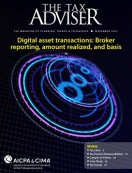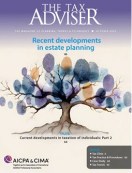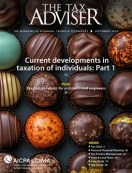- column
- DC CURRENTS
Using the IRS’s BBA Online Form Submission Service
Related
PTEs need more notice of changes, more time to respond, AICPA says
Tax Court applies limited partner functional test for self-employment income
Final partnership adjustment not issued timely
Editor: Melissa L. Wiley, J.D.
The Bipartisan Budget Act of 2015 (BBA), P. L. 114-74, introduced a new centralized partnership audit regime for IRS partnership return audits. The default rule under the BBA is that the audited partnership is liable for an “imputed underpayment” determined with respect to any partnership adjustment. The partnership can reduce its imputed underpayment amount through modification procedures, or in lieu of paying the imputed underpayment, the partnership can make a push-out election and have its partners pay the tax on the adjustments.
This column discusses the IRS’s BBA Online Form Submission Service (BBA OFSS) used by audited partnerships — and passthrough partners that directly or indirectly hold an interest in an audited partnership — to submit modification requests or to push out adjustments resulting from a BBA audit. The column also provides a general overview of the BBA OFSS form submission process and highlights some traps for the unwary.
BBA OFSS overview
After proposing an adjustment in a BBA exam, the IRS determines the imputed underpayment attributable to that adjustment and notifies the partnership of the imputed underpayment amount. To request a modification to the imputed underpayment or to push out the underlying adjustment, an audited partnership must utilize the BBA OFSS. The BBA OFSS is an online system created by the IRS for audited partnerships and passthrough partners to electronically submit the forms needed to request a modification or to effectuate a push-out election, including Form 8980, Partnership Request for Modification of Imputed Underpayments Under IRC Section 6225(c); Form 8988, Election for Alternative to Payment of the Imputed Underpayment — IRC Section 6226; Form 8985, Pass-Through Statement — Transmittal/Partnership Adjustment Tracking Report (Required Under Sections 6226 and 6227); and Form 8986, Partner’s Share of Adjustment(s) to Partnership-Related Item(s) (Required Under Sections 6226 and 6227).
The BBA OFSS only accepts IRS forms related to modification requests and push-outs submitted in connection with IRS exam adjustments. Any forms related to an administrative adjustment request (AAR) filed under the BBA are not submitted via the BBA OFSS. (For more discussion of the AAR process, see Armstrong, “Filing an Administrative Adjustment Request Under the BBA,” 55-6 The Tax Adviser 22 (June 2024) .)
The IRS’s “Electronic Submission of Forms by Audited BBA Partnerships and Their Pass-through Partners” webpage provides guidance on and a link to the BBA OFSS. The webpage includes a step-by-step guide, details on required file formats, guidance on signature requirements, and a short list of frequently asked questions.
How to use the BBA OFSS
Establishing an ID.me account
The first step when engaging with the BBA OFSS is to establish an account with ID.me, a third-party provider that supplies authentication and identity verification for taxpayers and tax professionals accessing IRS applications. Signing up for ID.me requires providing personal information, uploading government documentation, and making a video recording or interview to confirm the individual’s identity. The enrollment process can take several days depending on the availability and quality of one’s documentation.
Applying for a PBBA TCC
Once an ID.me account is established, the user completes a PBBA TCC application to obtain a Partnership Bipartisan Budget Act Transmitter Control Code (PBBA TCC), a five-character alphanumeric code beginning with the letters PB. The PBBA TCC enables an audited BBA partnership or passthrough partner to electronically submit forms via the BBA OFSS. Each audited partnership and passthrough partner must obtain a unique PBBA TCC.
The PBBA TCC application asks for basic information including the type of legal entity, legal name, and physical address of the entity. The IRS recommends listing two individuals from the audited partnership, or the passthrough partner, on the PBBA TCC application: one individual as the “responsible official” and at least one individual as a “contact.” (Any person listed on the application must have an account.)
Only a person identified as the responsible official or contact may sign a required form by using a five-digit, user-created PIN. Because many of the relevant forms must be signed by the partnership representative, one of the individuals listed would typically be the partnership representative (or a designated individual in the case of an entity acting as the partnership representative). The IRS’s electronic submission of forms webpage specifies which forms can be signed by the partnership representative and which of them can be signed by a power of attorney on behalf of the partnership representative; the webpage also indicates which forms require a manual signature.
At the end of the application process, the PBBA TCC should be viewable on-screen. The IRS will also confirm the PBBA TCC by mail (Letter 6295C). The IRS advises waiting 72 hours after issuance of the PBBA TCC before taking any further steps, including uploading any forms. In addition, prior to uploading any push-out forms, the audited partnership or passthrough partner must request an Outgoing Tracking Number to enter on Form 8985 and on each Form 8986. Also, the audit control number assigned by the IRS at the beginning of the relevant exam must be reflected on each form stemming from that audit.
Understanding system idiosyncrasies and potential traps
Although the process may appear straightforward on the surface, the BBA OFSS has some idiosyncrasies and potential traps that warrant mention. The first, which may be apparent from the discussion above, is that the process of signing up and obtaining the needed data to submit the forms can be time-consuming. It is not a process to start the night before the submission deadline.
Note that only the official IRS versions of the modification and push-out forms can be submitted through the BBA OFSS, and the forms must be submitted in their original, fillable PDF format. Because the forms need to be readable by IRS systems, the forms cannot be printed, scanned, and uploaded to the system (with the exception of certain signature pages).
The IRS advises that forms should have a unique and descriptive file name and that generic file names, such as “Modification attachment” or “Pushout form,” not be used. File names can only be a maximum of 50 characters and must use the exact file extension permitted by the system.
For example, a file must end with a “.pdf” extension and not with a “.PDF” extension. For forms that require a signature, the name of the person signing the relevant form must exactly match the name that was entered on the PBBA TCC application. (Recall that only a person listed on the PBBA TCC application can sign the form.)
For example, if the name entered on the PBBA TCC application was “Gregory T. Armstrong,” the typed name on the form must show exactly as “Gregory T. Armstrong,” not “Gregory Armstrong” or “Greg Armstrong.” The name is also case-sensitive. Therefore, “Gregory T. Armstrong” cannot be shown as “GREGORY T. ARMSTRONG” on the form.
After the forms are submitted, the system will produce a “receipt ID” with a list of submitted forms. The receipt ID does not mean that the IRS has accepted the submission, however. Each filer must reenter the system to check that its submission was accepted or rejected and, if rejected, resubmit the relevant forms.
In the case of a tiered structure, the “accepted” status of each tier’s submission is critical. The lower tier’s submission must be accepted before the system will permit the upper tier to submit its own forms. The submission order, therefore, is crucial in the case of multiple tiers having the same submission deadline.
Engage with the BBA OFSS early
For an audited partnership, passthrough partner, or practitioner about to engage with the BBA OFSS, the earlier the engagement is begun, the better the partnership’s chances of completing the process timely. Although on the surface the process may appear manageable, the process contains potential traps for the unwary, and the process to sign up and obtain the required data may take longer than expected.
For questions and issues not resolved by the available guidance, the IRS offers assistance through the PBBA eSubmission Helpdesk. BBA OFSS users can reach the helpdesk via a voice mailbox at 813-367-8037 or by email at lbi.bba.esubmit@irs.gov. Tax professionals can also subscribe to the “e-News for BBA Partnerships” newsletter to receive notifications of updates to the BBA webpage.
Contributors
Gregory T. Armstrong, J.D., LL.M., is director–Practice, Procedure, and Administration with Tax Controversy and Dispute Resolution, Washington National Tax, KPMG LLP, in Minneapolis. Melissa L. Wiley, J.D., is a partner with Lowenstein Sandler LLP in Washington, D.C. Armstrong is a member, and Wiley is chair, of the AICPA IRS Advocacy & Relations Committee. For more information about this column, contact thetaxadviser@aicpa.org.














